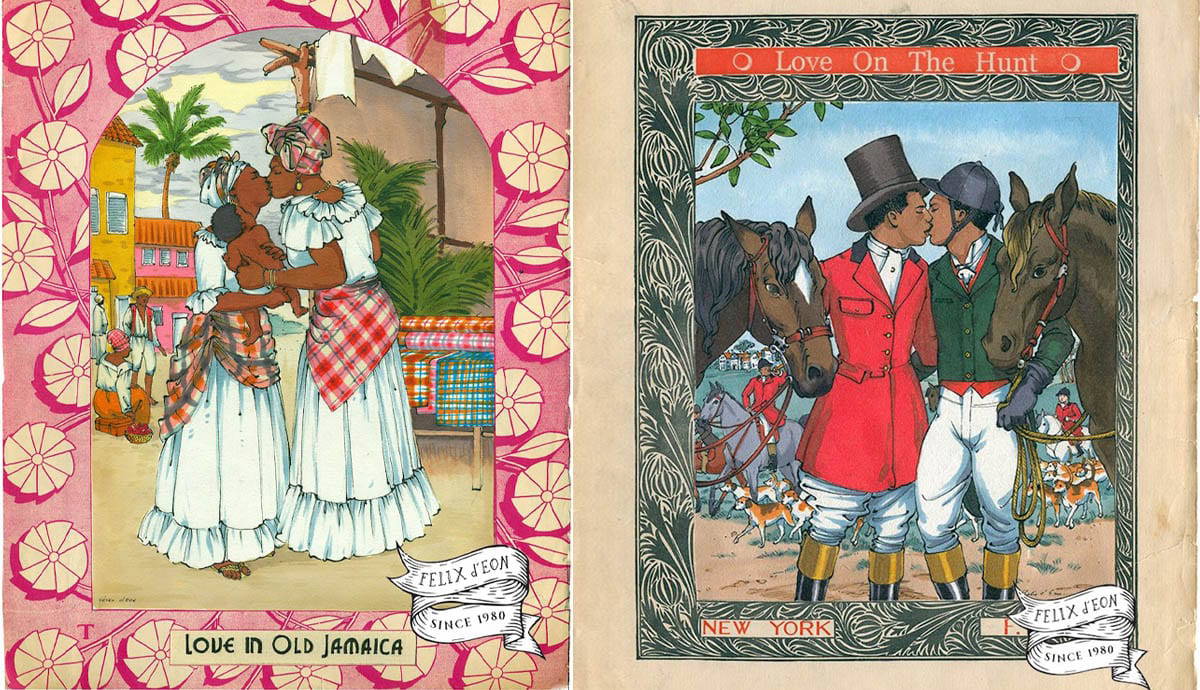
Throughout history and into the present, art has functioned as a source of solidarity and liberation for folks in the LGBTQIA+ community. No matter where in the world the artist or the audience comes from or what obstacles they may have faced as LGBTQIA+ people, art is the bridge for people from all walks of life to come together. Here is a glimpse of ten extraordinary LGBTQIA+ artists who use their art to connect to their queer audience and to explore their own unique identities.
First, let’s look at five deceased artists who paved the way for the LGBTQIA+ artists of today. No matter the social or political climate surrounding them, they pushed past those obstacles to create art that spoke to their LGBTQIA+ identity and audience.
19th-Century LGBTQIA+ Artists
Simeon Solomon (1840-1905)

Regarded by some scholars as “the Forgotten Pre-Raphaelite,” Simeon Solomon was Jewish artist in England during the late 19th century. Solomon was a remarkable person that despite the many challenges he faced, continued to produce beautiful art that would explore his unique and multifaceted identity.
In Sappho and Erinna, one of Solomon’s most famous works, the Greek poet Sappho, a legendary person that has become synonymous with her lesbian identity, is sharing a tender moment with lover Erinna. The two explicitly share a kiss — this soft and romantic scene doesn’t leave much room for any heterosexual interpretations.
Get the latest articles delivered to your inbox
Sign up to our Free Weekly Newsletter

Sensual physical closeness, androgynous figures, and natural environments are all elements used by the Pre-Raphaelites, but Solomon used this aesthetic style to represent folks like him and to explore homoerotic desire and romance. Solomon would eventually be arrested and imprisoned for “attempted sodomy,” and at this time would be rejected by the artistic elite, including many of the Pre-Raphaelite artists he had come to look up to. For many years he lived in poverty and social exile, however, he made artwork with LGBTQIA+ themes and figures until his death.
Violet Oakley (1874-1961)

If you’ve ever walked the streets and toured the historic sites in the city of Philadelphia, Pennsylvania, you most likely have come face to face with a number of works by Violet Oakley. Born in New Jersey and active in Philadelphia at the turn of the 20th century, Oakley was a painter, illustrator, muralist, and stained glass artist. Oakley was inspired by the Pre-Raphaelites and the Arts and Crafts Movement, attributing her range of skills.
Oakley was commissioned to do a series of murals for the Pennsylvania State Capitol building that would take 16 years to complete. Oakley’s work was a part of other notable buildings in Philadelphia, such as the Pennsylvania Academy of Fine Arts, the First Presbyterian Church, and the Charlton Yarnell House. The Charlton Yarnell House, or The House of Wisdom, as it was called, contains a stained-glass dome and murals including The Child and Tradition.

The Child and Tradition is a perfect example of Oakley’s forward thinking perspective that was present in nearly all her works. Murals containing visions of a feminist world where men and women exist equally, and where a domestic scene such as this is represented in an inherently queer light. Two women raise the child, and are surrounded by allegorical and historical figures symbolizing a diverse and progressive education.
In Oakley’s life, she would be awarded high medals of honor, receive major commissions, and teach at the Pennsylvania Academy of Fine Arts, becoming the first woman to do many of these things. She did all of this and more with the support of her life partner, Edith Emerson, another artist and lecturer at the PAFA. Oakley’s legacy is one that defines the city of Philadelphia to this day.
20th-Century LGBTQIA+ Artists
Claude Cahun (1894-1954)

Claude Cahun was born in Nantes, France, on October 25, 1894 as Lucy Renee Mathilde Schwob. By her early twenties, she would take the name Claude Cahun, chosen for its gender neutrality. In the 19th and early 20th century, France was thriving with people who questioned the social norms, such as gender identity and sexuality, giving folks like Cahun the space to explore themselves.
Cahun primarily did photography, though she also acted in plays and various performance art pieces. Surrealism defined much of her work. Using props, costumes, and makeup, Cahun would set the stage to create portraits that would challenge the audience. In nearly all of Cahun’s self portraits, she looks directly at the viewer, such as in Self Portrait with Mirror, where she takes a stereotypically feminine motif of a mirror and evolves it into a confrontation about gender and the self.

In the 1920s, Cahun moved to Paris with Marcel Moore, her life partner, and fellow artist. The pair would collaborate for the rest of their lives in art, writing, and activism. During World War II, when the Germans began to occupy France, the two moved to Jersey, where they fought tirelessly against the Germans by writing poems or printing British news about the Nazis and placing these fliers in public places for Nazi soldiers to read.
Beauford Delaney (1901-1979)

Beauford Delaney was an American painter who used his work to understand and cope with his internal struggles surrounding his sexuality. Born in Knoxville, Tennessee, his artistic vision would take him to New York during the Harlem Renaissance, where he would befriend other creatives like him, such as James Baldwin.
“I learned about light from Beauford Delaney” Baldwin says in an interview for the magazine Transition in 1965. Light and darkness play major roles in Delaney’s Expressionist paintings, such as this Self-Portrait from 1944. In it, one immediately notices the striking gaze. Delaney’s eyes, one black and one white, seem to call your attention and force you to contemplate his struggles and thoughts, and reveal to the audience a transparent and vulnerable place.

Delaney used his art to discuss universal issues as well. He made paintings of key Civil Rights figure Rosa Parks, in his Rosa Parks series. In an early sketch of one of these paintings, Parks is sitting alone on a bus bench, and written next to her the words “I will not be moved.” This powerful message rings throughout Delaney’s works and continues to shape his inspiring legacy.
Tove Jansson (1914-2001)

Tove Jansson was a Finnish artist most known for her Moomin comic books, which follow the adventures of the Moomin trolls. Although the comics are more geared for children, the stories and characters address a number of adult themes, making them popular to readers of all ages.
Jansson had relationships with men and women in her life, but when she attended a Christmas Party in 1955, she met the woman who would be her life partner, Tuulikki Pietilä. Pietilä was herself a graphic artist, and together, they would grow the world of the Moomins and use their work to talk about their relationship and the struggles of being queer in a not so accepting world.

There are many parallels between the characters of Moominvalley and the people in Jansson’s life. The character Moomintroll [left] represents Tove Jansson herself, and the character Too-Ticky [right] represents her partner Tuulikki.
In the story Moominland Winter, the two characters talk about the strange and unusual season of winter, and how some creatures can only come out during this quiet time. In this way, the story cleverly depicts the universal LGBTQIA+ experience of being closeted, coming out, and having the freedom to express one’s identity.
Now, let’s look at five unapologetic artists who are using their art today to speak their truths. You can discover more and even support some of these folks in the links embedded below.
Contemporary LGBTQIA+ Artists You Should Know
Mickalene Thomas (New York, U.S.A.)
Born in Camden, New Jersey and active now in New York, Mickalene Thomas’ bold collages, murals, photos, and paintings showcase black LGBTQIA+ folks, particularly women, and seek to redefine the often white/male/heterosexual art world.

The composition of Les Trois Femmes Noir might look familiar to you: Édouard Manet’s Le Déjeuner sur l’herbe, or Lunch on the Grass, is a mirror image to Thomas’ painting. Taking artworks throughout history that are deemed “masterworks” and creating art that speaks to a more diverse audience is a trend in Thomas’ art.
In an interview with the Seattle Art Museum, Thomas says:
“I was looking at Western figures like Manet and Courbet to sort of find a connection with the body in relationship to history. Because I was not seeing the black body written about art historically, in relationship to the white body and the discourse- it wasn’t there in art history. And so I questioned that. I was just really concerned about that particular space and how it was void. And wanted to find a way of claiming that space, of aligning my voice and art history and entering this discourse.”

Thomas takes subjects such as the female nude, one that is often under the male gaze, and reverts them. By photographing and painting friends, family members, and lovers, Thomas creates a real connection to the individuals she looks to for artistic inspiration. The tone of her work and the environment in which she creates it is not one of objectivity, but rather of liberation, celebration, and community.
Zanele Muholi (Umlazi, South Africa)
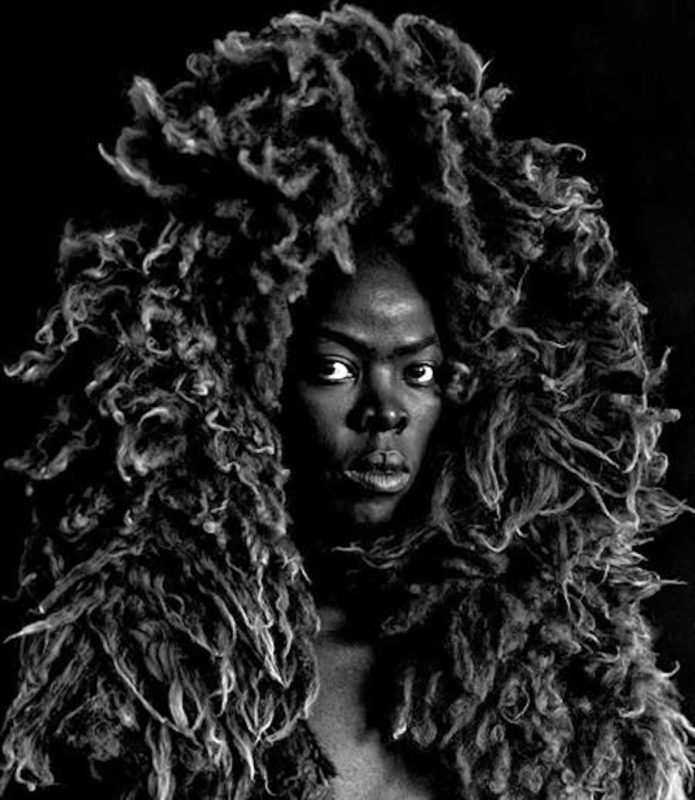
An artist and activist, Muholi uses intimate photography to create affirming captures and spark honest discussions about transgender, non-binary, and intersex folks. Whether the scene is one of laughter and simplicity, or a raw portrait of the individual engaging in explicitly transgender rituals such as binding, these photos give light to the lives of these often erased and silenced people.
By seeing photos of trans, non-binary, and intersex folks simply being themselves and going about everyday routines, fellow LGBTQIA+ viewers can feel solidarity and validation in their visual truths.
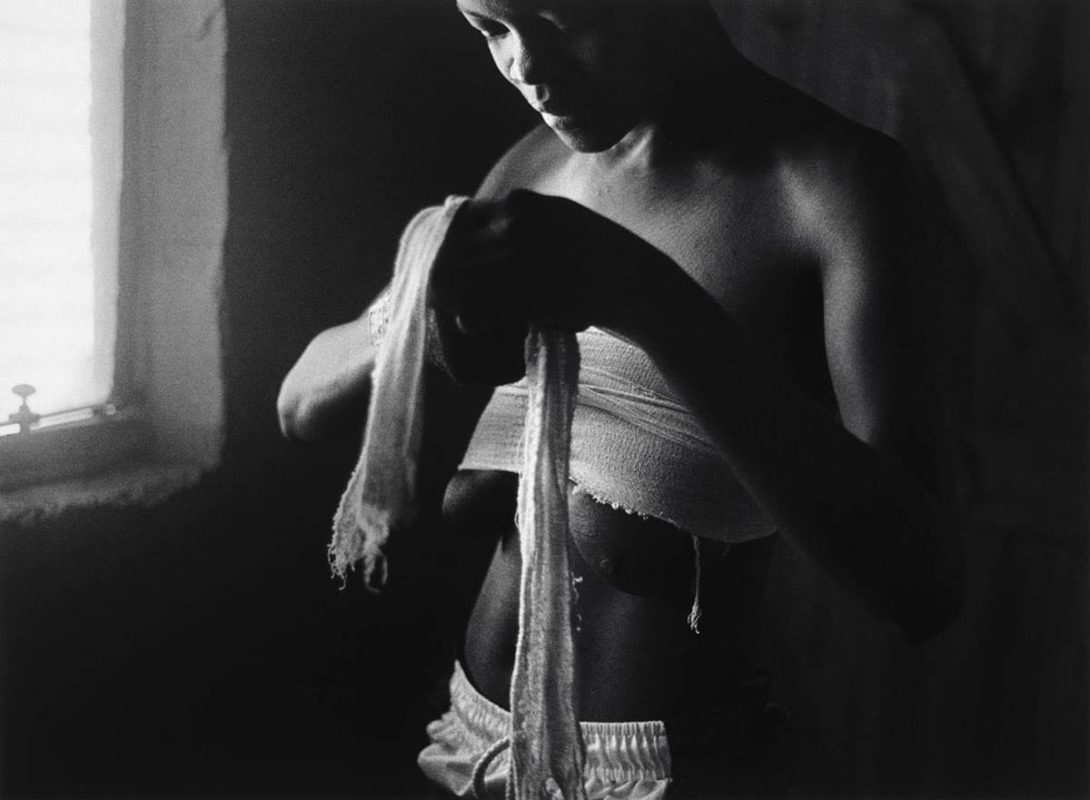
ID Crisis shows an individual engaging in the practice of binding, one that many trans and non-binary folks can relate to. Muholi often captures these kinds of acts, and in this transparency, illuminates the humanity of trans folks to their viewers, no matter how they identify. Muholi creates in their work honest, true, and respectful representation, and that kind of work is critical. Zanele Muholi’s art has been exhibited in major museums such as the Tate, the Guggenheim, and the Johannesburg Art Museum.
Kjersti Faret (New York, U.S.A.)
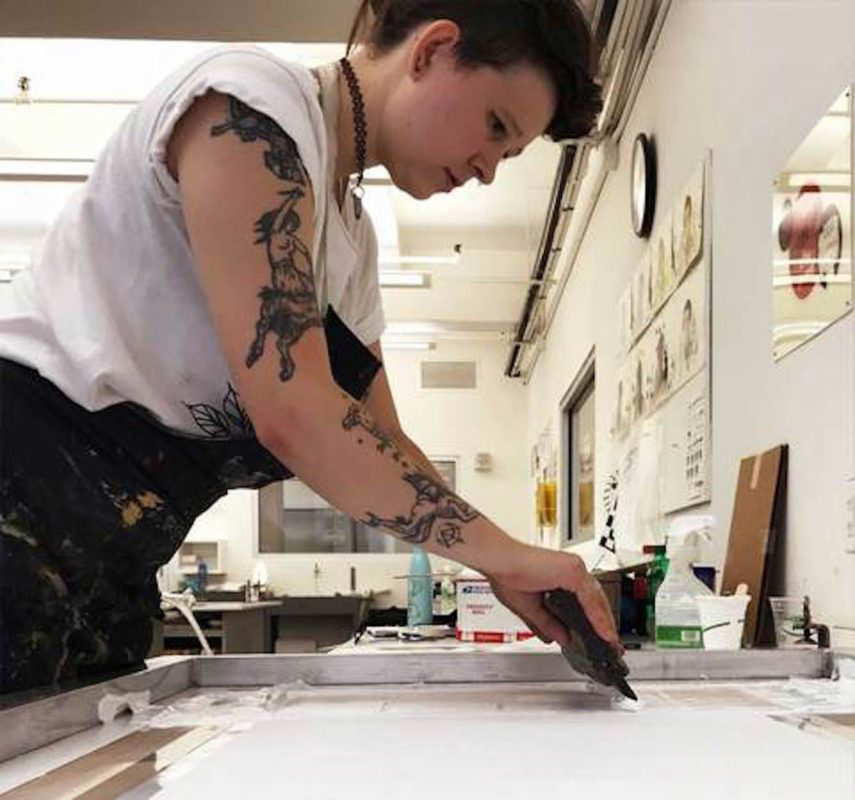
Kjersti Faret is an artist who makes her living selling her artwork on apparel, patches and pins, and paper, all silk-screen printed by hand. Her work is largely inspired by medieval manuscripts, Art Nouveau, her Norwegian heritage, the occult, and most notably, her cats. Using aesthetics inspired by art movements of the past, and with a magical twist, Faret creates scenes of enchantment, humor, and often, queer representation.
In her painting, Lovers, Faret creates a whimsical fairy tale scene of a harpy lesbian romance. Faret shares her thoughts on the painting on her Instagram page @cat_coven:
“It started as an experimental paper cut, of just the golden brown harpy. Once she was mostly done I wanted to create an environment to set her in. I’ve also been feeling the need to make some gay art, and thus her lover was born. I let my subconscious kind of lead me on the journey of finishing the illustration. Spontaneously, I made little creatures to inhabit the world, to cheer on the lovers. I imagine this as the moment after their epic love story where they finally end up together, that moment right before they kiss and “The End” scrawls across the screen. A celebration of queer love.”
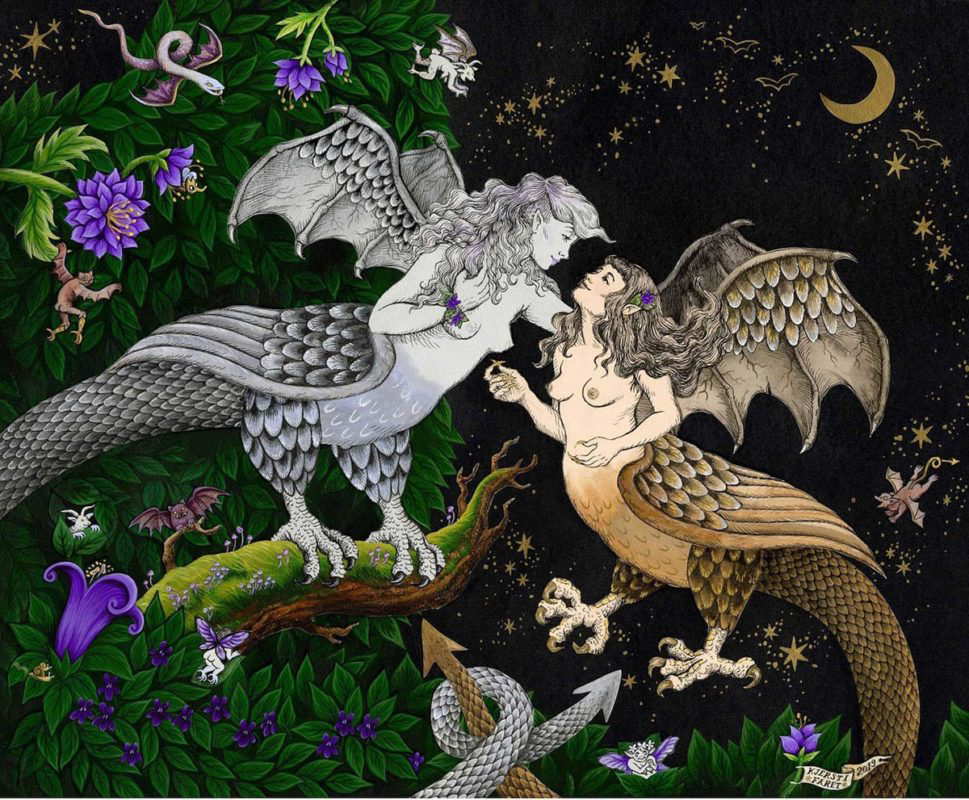
Last year, Faret hosted a fashion and art show in Brooklyn with other queer creatives called the “Mystical Menagerie.” Handmade garments and costumes inspired by medieval art were showcased on the runway, and there were also booths for dozens of local artists to exhibit and sell their work. Faret continues to update her art shop regularly, creating everything from the first sketch to the whimsical parcel that arrives in your mailbox.
Shoog McDaniel (Florida, U.S.A.)

Shoog McDaniel is a non-binary photographer who creates stunning images that redefine fatness and celebrate bodies of all sizes, identities, and colors. By taking models into various outdoor environments, like a rocky desert, a Floridian swamp, or a garden of flowers, McDaniel finds harmonious parallels in the human body and in nature. This powerful action asserts that fat is natural, unique, and beautiful.
In an interview with Teen Vogue, McDaniel shares their thoughts on the parallel between fat/queer folks and nature:
“I’m actually trying to work on this book about bodies called Bodies Like Oceans … The concept is that our bodies are vast and beautiful and like an ocean, they’re filled with diversity. It’s basically just a comment on what we go through everyday and the beauty that we have and that is not seen. That’s what I’m going to be highlighting and the parts of the bodies, I’m going to take pictures from underneath, I’m going to take pictures from the side, I’m gonna show the stretch marks.”
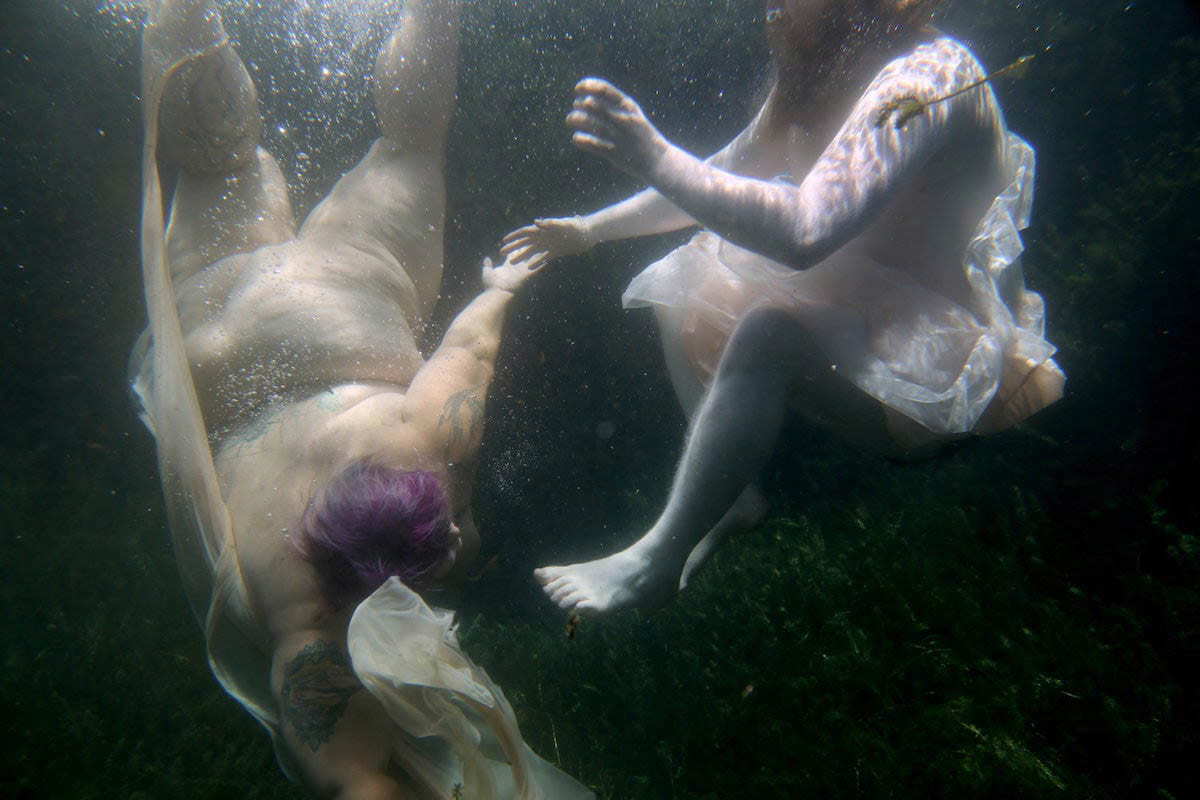
Touch, one of McDaniel’s many photos featuring models underwater, shows the gravity play of fat bodies moving naturally in water. You can see the rolls, the soft skin, and the push and pull as the models swim. McDaniel’s mission to capture fat/queer folks in natural environments produces nothing short of magical artworks that give solidarity to fat LGBTQIA+ folks.
Felix d’Eon (Mexico City, Mexico)
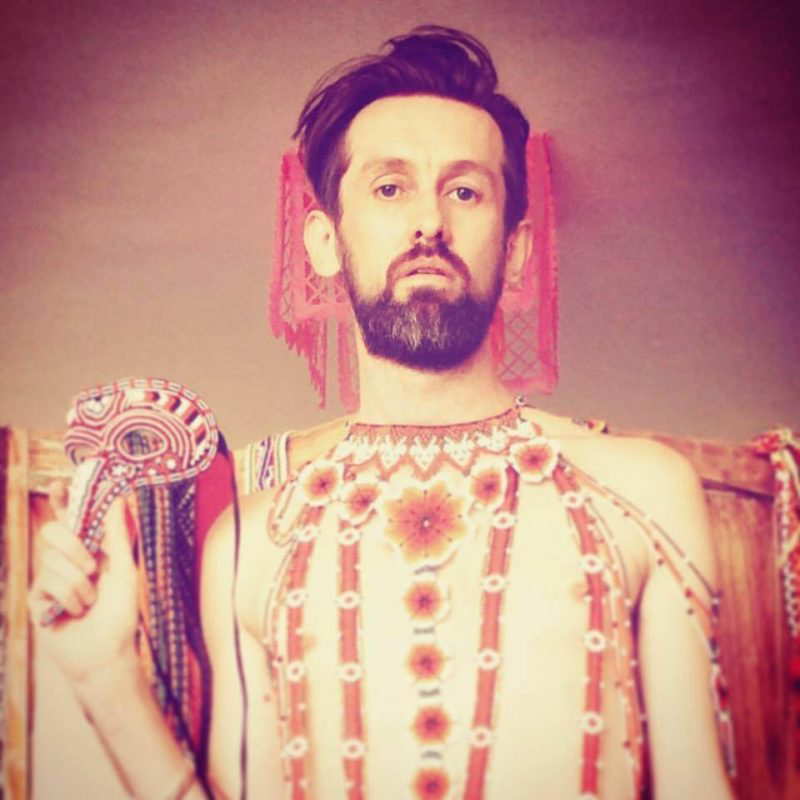
Felix d’Eon is “a Mexican artist dedicated to the art of queer love,” (from his Instagram bio) and truly, his work represents the wide spectrum of LGBTQIA+ folks from all over the world. A piece might be of a two-spirit Shoshone person, a gay Jewish couple, or a group of trans satyrs and fauns frolicking in the woods. Every painting, illustration, and drawing is unique, and no matter your background, identity, or sexuality, you will be able to find yourself in his works.
There is definitely an awareness of art history in d’Eon’s art. For example, If he chooses to paint a Japanese couple from the 19th century, he will do so in the style of Ukiyo-E woodblock prints. He also makes mid-century styled comic strips, with gay superheroes and villains. Sometimes he will take a historical figure, perhaps a poet, and make a piece based off of a poem they wrote. A large facet of d’Eon’s work is of traditional Mexican and Aztec folklore and mythology, and he most recently created an entire Aztec tarot deck.

Felix d’Eon creates art that celebrates all LGBTQIA+ folks and places them in environments whether contemporary, historical, or mythological. This enables his LGBTQIA+ audience to see themselves within art history’s narrative. This mission is vital. We must examine art of the past and redefine art of the present in order to create an honest, inclusive, and accepting artistic future.








